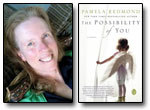 One of the best things about writing a historical novel like my new book THE POSSIBILITY OF YOU, which is set in 1916 and 1976 along with the present, is that you have to do a lot of reading. Having to do a lot of reading in the name of research is good because it delays the actual writing. Instead, you can lie on the sofa, surrounded by pillows and covered by a nice soft blanket, and tell yourself that you’re working.
One of the best things about writing a historical novel like my new book THE POSSIBILITY OF YOU, which is set in 1916 and 1976 along with the present, is that you have to do a lot of reading. Having to do a lot of reading in the name of research is good because it delays the actual writing. Instead, you can lie on the sofa, surrounded by pillows and covered by a nice soft blanket, and tell yourself that you’re working.
Whether you’re really working, whether the books you’re reading are absolutely necessary to the writing of your historical novel or not, is a matter of degree. Sometimes, yes, that book on your lap is one that you couldn’t write your own book without reading from cover to cover. And sometimes what you get from reading other books is simply inspiration or flavor, more essential to your spirit as a writer than to maneuvering your characters and plot from page one through to the end.
Here, the books I read that helped me write THE POSSIBILITY OF YOU:
CENTURY GIRL by Lauren Redniss --- CENTURY GIRL is a gorgeous, inspired graphic biography of the Ziegfeld Follies girl Doris Eaton Travis, who started dancing on Broadway around 1916 and who lived to be 106. I read CENTURY GIRL at the beginning of my work to learn more about my character Maude, herself a Ziegfeld Follies girl. Redniss’s work made this character and this time come alive in a more vivid and entertaining way than any photograph or biography alone could have. One of my favorite books, period.
DIRT AND DISEASE by Naomi Rogers --- I decided to write about the 1916 polio epidemic in New York before I knew that this scholarly and highly-detailed work about the event even existed. I was also lucky enough to interview author and Yale professor Naomi Rogers, who not only illuminated the historical details but helped me posit what really might have happened when Floyd got sick: “How sick would he have seemed?,” I asked her. “How quickly would the disease have progressed?” Rogers and her book made me feel as if my fictional story was true.
THE HOURS by Michael Cunningham --- I didn’t set out to model THE POSSIBILITY OF YOU on THE HOURS, which is one of my favorite novels ever. But as the story evolved from a historical novel with a modern framing story to the tale of three women at three different time periods, THE HOURS became a logical model of the form. I deconstructed that book to see how Cunningham had done it: How long were the chapters, how were the time periods interwoven and in what way did the themes tie the stories together?
Enough time has passed since THE HOURS was first published that this generation of readers and writers often hasn’t read it. It’s a book that deserves to be discovered anew and I envy the reader who gets to read it now for the first time. Each time I read it, I find that a different character becomes my favorite and that I gain a new insight into the book and its themes.
After I did my grand study of THE HOURS and revised my own book using it as inspiration, I was in New York walking around Little Italy to sketch out the place where my contemporary character, Cait, lives. After a long day, I wanted to collapse in a coffee shop, but though my feet were killing me and I was exhausted, I kept trudging through the streets in search of the perfect coffee shop. Finally, I found it, and when I went inside and sat down, I looked around the room only to see Michael Cunningham himself, sitting at the next table.
My first impulse was to rush over and tell him that I’d read every interview ever done with him, that I knew his book inside out and loved it more than anything. I wanted to tell him that I’d used his work as a kind of spirit guide for my own, and that it seemed an amazing psychic event to find myself in that place with him.
But then I thought, No, this is enough. I’ll just seem like a crazy person and this means so much more to me than it ever could to him. So I drank my coffee, buzzing with the atmosphere, feeling as if being in his presence was a message that I had done the right thing with my book.
In the middle of the book, in one of the 1976 chapters, there’s an important scene in which Billie bakes a cake for Bridget and Jupe. That’s my direct homage to THE HOURS, and readers who know both books will recognize it.


